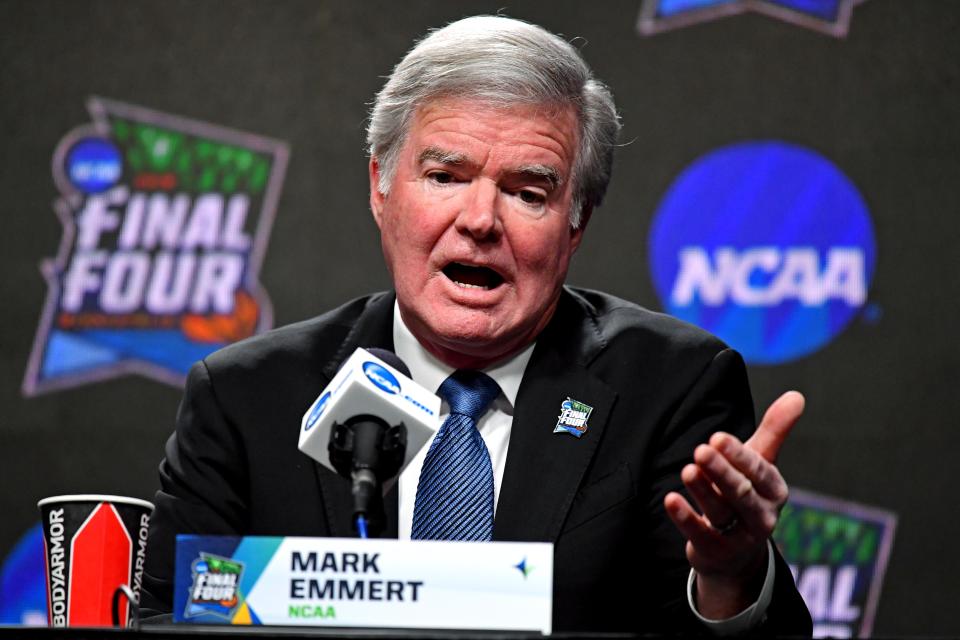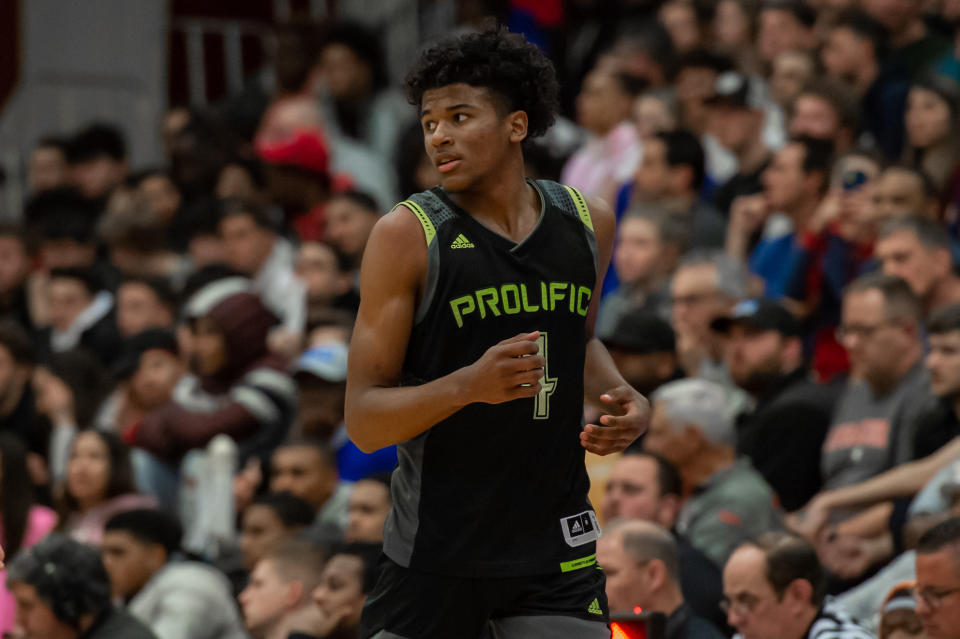How college hoops leaders can save face and fix talent woes with one rule change
Sorry, but college basketball isn’t going to fold because elite players are increasingly finding non-campus avenues to the NBA — including 2020 top recruit Jalen Green signing a half-million dollar G League deal Thursday.
Tradition still matters. Pageantry still matters. The name on the front of the jersey still matters.
March still matters. Lots of fans will be there.
College hoops does have a talent problem. It needs more of it. Better is always better. The fewer good players, the harder the action is on the eyes, causing casual viewers to ignore the sport until the bracket comes out.
What the Green deal showed, once again, is that players have a far higher free-market value than the NCAA claims (tuition, room, board, etc.). Since not even the most rebellious of college coaches can compete with the NBA version of a “strong-ass offer,” the sport shouldn’t even try.
The Greens of the world are gone. Just wish them well.
College basketball should, however, limit self-inflicted wounds born of decades of backward thinking, poor leadership and disrespect (rooted in old-school racism) toward potential NBA players.
It needs to stop kicking out dozens of high-quality athletes just because (A) they dare to dream of being a pro, and (B) college hoops has refused to stand up for itself and instead allowed the draft process to be run to the NBA’s full benefit.
Start with this: The NBA isn’t your friend. It’s your competition. And while you’ll never win a bidding war against it, you can recoup some of the losses by making the league treat you as a partner in talent development rather than a weakling to be raided … after your one-of-a-kind tournament turns these kids into marketable stars, of course.
The easiest fix: Change NCAA basketball rules concerning the NBA draft to mirror the NCAA hockey rules concerning the NHL draft.

Basketball currently requires underclassmen to first declare they are entering the draft (because that’s what the NBA wants). They then have until 10 days after the draft combine to say they are remaining in the draft (because that’s what the NBA wants). If they stay in, then they are banned from college basketball (which provides the NBA with all the leverage).
In college hockey, or nearly any other NCAA sport, the rule is different. No hockey player has to declare for the draft. As such, no one has to pull themselves out of the draft. Even if a player is selected by an NHL team, they aren’t banished from college hockey.
Instead, the player has 72 hours after the draft to sit down with their family, an agent (yes, it’s allowed), their NHL team and their college coach and determine the best path forward — play for their school or go pro. Seems reasonable, right? After all, it’s a big decision.
If you choose the NHL, good for you. If you choose college, then you can’t join an NHL team until after your college team’s season ends. You’re committed.
The system works. There are almost no complaints. There are no college hockey coaches begging to switch to the college basketball system. There is roster uncertainty into the summer, but that’s the trade-off to work with great young players.
Basketball, however, requires players to make one of the biggest decisions of their life based on rumors, promises and projections. It treats the process, and the families making it, with disdain, a throwback to old totalitarian coaches who considered it disloyal for an underclassmen to even consider turning pro.
That one draft is filled overwhelmingly with white kids and the other overwhelmingly with African-Americans is not a coincidence.
This isn’t 1975 anymore though. Let the vestiges of those times be over as well.
This is a self-inflicted wound that does exponentially more to lower the talent and excitement level of college basketball than a few one-and-dones choosing Australia or the G League rather than UCLA.
This is the crisis, not Jalen Green.
In 2019, 84 underclassmen went through the NBA pre-draft process and decided to keep their name in the draft. Just 40 were picked. That meant 44 players still had college eligibility, yet were screwed. Plenty of others were no doubt disappointed with their draft selection — second round, not high enough in the first, not the team they preferred, buyer’s remorse, whatever.
Would all of them have chosen to return to college? No, but a lot would, especially without having to go through the contentious declaration process or the embarrassment of draft night not going as they hoped. That’s dozens of really good players who could have improved the quality of play at programs across the country.
Yet rather than find a way to keep them, college hoops seems to enjoy mocking them for overvaluing their worth.
College hockey just welcomes them back to practice.

There are a few differences between the systems. Since the NHL doesn’t require anyone to declare for the draft, picking a player is a bit risky because you don’t know if they are going to come or go back to school. Oh, well. That’s the NHL’s burden.
College basketball instead does the NBA a great service by making players renounce their eligibility, essentially handcuffing them to the pro game. Thanks to the NCAA playing the NBA’s fool, the NBA has full control.
If college hoops allowed the players to retain their eligibility until after the draft, then the list of “eligible” players would be moot. Suddenly everyone is eligible to go … or stay.
The NBA would have to begin selecting college players with the understanding they might not get them immediately. It’s not a big deal. That’s exactly what the league does with international players who routinely stay in Europe for more seasoning after getting selected.
What college basketball will find is that it's not just the undrafted players who might choose to return to campus. It won’t just be second-rounders either.
In the 2019 NHL draft, nine first-round picks decided to play this winter in college rather than the pro ranks. That includes the fifth, ninth, 12th and 13th overall selections (lottery picks, in NBA terms).
That’s a lot of high-end talent that adds a spark to college hockey. That’s a lot of players who see the value in the college experience. The Hobey Baker Award winner this year was the University of Minnesota-Duluth’s Scott Perunovich, a 2018 draft pick by the St. Louis Blues. If Perunovich played basketball, the sport would have booted out its player of the year.
How does that make sense? It doesn’t.
It stands to reason plenty of basketball players would make the same choice. Having a Gregg Popovich or a Doc Rivers help a young man map out their future isn’t a bad thing. There will be plenty of common ground, including NBA teams encouraging certain prospects to spend a season or three at Duke or Kentucky or even Murray State. It happens with the NHL now.
It would further make sense for college basketball to allow drafted players to work out in the offseason with pro teams or compete in the NBA Summer League and get paid as a sort of internship.
That’s with new legislation though. The draft rule change could be done overnight.
Essentially this boils down to hockey players being treated with respect, not just for themselves and their families, but for the delicate, confusing and extremely important transition into a professional career.
That dignity isn’t provided to basketball players. While the sport has loosened some things, including extending the deadline past the combine, it isn’t close to enough.
Instead, college hoops is playing by the NBA’s rules and against the best interests of young players and its own game.
It’s lose-lose for everyone and just a flat-out stupid way to run a sport.
More from Yahoo Sports:

